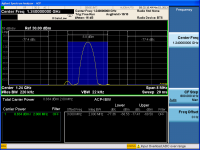
Analog Devices uses six designations to inform our customers where a semiconductor product is in its life cycle. From emerging innovations to products which have been in production for twenty years, we understand that insight into life cycle status is important. Device life cycles are tracked on their individual product pages on analog.com, and should always be consulted before making any design decisions.
This particular articl/edocument/design has been retired or deprecated, which means it is no longer maintained or actively updated, even though the devices themselves may be Recommended for New Designs or in Production. This page is here for historical/reference purposes only.
There are many specifications on the Transmit side of a RF system
Determining overall channel bandwidth is a little complex, since many devices don't have a meaningful (in this aspect) bandwidth number.
So, transmit bandwidth can be as high as 250 MHz, depending on if the flatness of the ADL5602 and ADL5375 works for your application.
 |  |
| ACP with LO of 1.2GHZ and Tone of 40MHz with full power out. | ACP with LO of 1.2GHZ and Tone of 40MHz with half power out. |
 |  |
| Phase Noise at LO of 400MHz and Tone of 40MHz with full power out. | Phase Noise at LO of 900MHz and Tone of 40MHz with full power out. |
 |  |
| Phase Noise at LO of 1.2GHz and Tone of 40MHz with full power out. | Phase Noise at LO of 1.2GHz and Tone of 40MHz with half power out. |
Intermodulation_Distortion or IMD
Although this doesn't have a specific number associated with it, many RF systems are “chirpy” - and linear response to these RF pulses is very important.
Here is a 2.4GHz waveform, input at -60dbB, with the VGA gain turned up to +20dB. Although this does have some DC offset (the card was not calibrated), the response is very linear over time, even when zoomed in. (Clicking on either picture will open it up in a larger window)
And with a larger input - it looks similar. This is with an input of +6.0dBm, with the VGA set to 4.5dB.|
The results are similar at different frequencies.|